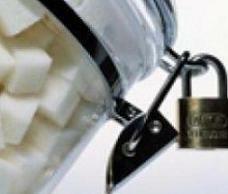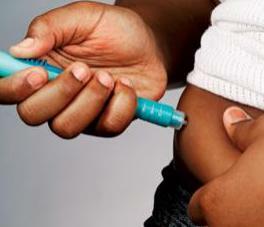 Diabetes mellitus type 1 refers to the classic autoimmune organ-specific disease, as a result of which destruction of insulin-producing β-cells of the pancreas occurs with the development of absolute deficiency of insulin.
Diabetes mellitus type 1 refers to the classic autoimmune organ-specific disease, as a result of which destruction of insulin-producing β-cells of the pancreas occurs with the development of absolute deficiency of insulin.
People who suffer from this disease need insulin therapy for type 1 diabetes, which means that they need daily injections of insulin.
Also very important for treatment are diet compliance, regular exercise and constant monitoring of blood glucose.
What it is?
Why does this disease occur, and what is it? Diabetes mellitus type 1 is an autoimmune disease of the endocrine system, the main diagnostic symptom of which is:
- Chronic hyperglycemia- high blood sugar.
- Polyuria, as a consequence of this - thirst; weight loss; excessive or decreased appetite; severe general fatigue of the body; stomach ache.
The most often ill people of young age (children, adolescents, adults under the age of 30), can be congenital.
Diabetes developswhen there is:
- Insufficient production of insulin by pancreatic endocrine cells.
- Violation of the interaction of insulin with cells of body tissues (insulin resistance) as a consequence of a change in the structure or a decrease in the number of specific receptors for insulin, a change in the structure of insulin itself or a violation of intracellular mechanisms of signal transmission from receptors to cell organelles.
Insulin is produced in the pancreas - an organ located behind the stomach. The pancreas consists of a cluster of endocrine cells called islets. Beta cells in the islets produce insulin and release it into the blood.
If the beta cells produce insufficient insulin or the body does not react to insulin, which is present in the body, Glucose begins to accumulate in the body, and not to be absorbed by cells, leading to pre-diabetes or diabetes.
Causes
Despite the fact that diabetes is one of the most common chronic diseases on the the planet, in medical science there is still no single-valued data on the causes of the development of this disease.
Often, for the possibility of developing diabetes, the following prerequisites are necessary.
- Predisposition on genetics.
- The decay of β-cells that make up the pancreas.
- This can occur, both under external adverse effects, and under autoimmune.
- The presence of constant stress psycho-emotional nature.
The term "diabetes" was first introduced by the Roman physician Aretius, who lived in the second century of our era. He described the illness as follows: "Diabetes is a terrible suffering, not very frequent among men, dissolving flesh and limbs in urine.
Patients, without ceasing, secrete water in a continuous stream, as through open water pipes. Life is short, unpleasant and painful, thirst is unquenchable, fluid intake is excessive and not commensurate with the huge amount of urine due to even greater diabetes. Nothing can stop them from taking liquids and releasing urine. If they for a short time refuse to take a liquid, they dry out in the mouth, the skin and mucous membranes become dry. The patients experience nausea, they are nervous, and die for a short time. "
What happens if I do not heal?
Diabetes mellitus is terrifying by its destructive influence on human blood vessels, both small and large. Doctors to those patients who are not engaged in treatment of type 1 diabetes mellitus, the forecast gives disappointing: the development of all heart diseases, damage to the kidneys and eyes, gangrene of the extremities.
Therefore, all doctors are advocating only that at the first symptoms you need to go to a medical institution and conduct tests for sugar.
Effects
The consequences of the first type are dangerous. Among the pathological conditions can be identified as follows:
- Angiopathy- Vascular damage on the background of energy insufficiency of the capillaries.
- Nephropathy- defeat of renal glomeruli against the background of blood supply disorders.
- Retinopathy- damage to the eye retina.
- Neuropathy- damage to the membranes of nerve fibers
- Diabetic foot- characterized by multiple lesions of limbs with cell death and the occurrence of trophic ulcers.
Without a substitute insulin therapy, a type 1 diabetes patient will not be able to live. With inadequate insulin therapy, against which the criteria for compensation of diabetes are not met and the patient is in a state of chronic hyperglycemia, late complications begin to develop rapidly and progress.
Symptoms
Hereditary disease type 1 diabetes mellitus can be detected by such symptoms:
- constant thirst and, consequently, frequent urination, leading to dehydration of the body;
- rapid weight loss;
- constant feeling of hunger;
- general weakness, rapid deterioration of well-being;
- the onset of type 1 diabetes is always acute.
Having found out any symptoms of diabetes, you need to immediately go through a medical examination. If such a diagnosis occurs, the patient needs regular medical supervision and constant monitoring of blood glucose.
Diagnostics
Diagnosis of type 1 diabetes in the vast majority of cases is based on the detection of significant fasting hyperglycaemia and during the day (postprandial) in patients with severe clinical manifestations of absolute insulin deficiency.
Results that show that a person has diabetes:
- Glucose in the blood plasma on an empty stomach is 7.0 mmol / L or higher.
- When carrying out a two-hour test for glucose tolerance, the result was 11.1 mmol / L and higher.
- Sugar in the blood with random measurement was 11.1 mmol / L or higher, and there are symptoms of diabetes.
- Glycated hemoglobin HbA1C - 6.5% or higher.
If there is a home glucose meter - just measure sugar for them, without having to go to the laboratory. If the result is higher than 11.0 mmol / l - this is probably diabetes.
Methods of treatment of type 1 diabetes mellitus
At once it is necessary to tell, that the diabetes of the first degree can not be cured. No medicine can regenerate cells that die in the body.
The goals of treatment of type 1 diabetes:
- Keep blood sugar as close to normal as possible.
- Monitor blood pressure and other factors of cardiovascular risk. In particular, to have normal blood test results for "bad" and "good" cholesterol, C-reactive protein, homocysteine, fibrinogen.
- If complications of diabetes do manifest, then discover it as soon as possible.
- The closer the sugar in a diabetic to normal parameters, the lower the risk of complications in the cardiovascular system, kidneys, eyesight, legs.
The main direction in the treatment of type 1 diabetes is the constant control of blood sugar, insulin injections, diet and regular exercise. The goal is to keep blood glucose within normal limits. Tighter control of blood sugar levels can reduce the risk of diabetes-related heart attack and stroke by more than 50 percent.
Insulin therapy
 The only possible way to help a patient with type 1 diabetes is to prescribe insulin therapy.
The only possible way to help a patient with type 1 diabetes is to prescribe insulin therapy.
And the sooner a treatment is prescribed, the better will be the general condition of the body, since the initial stage of diabetes mellitus 1 degree characterized by inadequate insulin production by the pancreas, and later it ceases to produce it at all. And there is a need to introduce it from the outside.
Dosages of drugs are selected individually, while trying to simulate the fluctuations of insulin in a healthy person (maintaining the background level of secretion (not associated with the intake of food) and postprandial - after eating). For this use insulin of ultrashort, short, medium duration of action and long-term action in various combinations.
Usually, prolonged insulin is administered 1-2 times a day (morning / evening, morning or evening). A short insulin is injected before each meal - 3-4 times a day and as needed.
Diet
To have good control of type 1 diabetes, you need to learn a lot of different information. First of all, find out which foods raise your sugar, and which ones do not. Diabetic diet can be used by all people who follow a healthy lifestyle and wants to preserve youth and a strong body for many years.
First of all it is:
- Exclusion of simple (refined) carbohydrates (sugar, honey, confectionery, jam, sweet drinks, etc.); use, in the main, complex carbohydrates (bread, cereals, potatoes, fruits, etc.).
- Compliance with regular meals (5-6 times a day in small portions);
Restriction of animal fats (fat, fatty meat, etc.).
Sufficient inclusion of vegetables, fruits and berries in the diet is useful, as they contain vitamins and trace elements, are rich in dietary fiber and provide a normal metabolism in the body. But it should be borne in mind that in the composition of some fruits and berries (prunes, strawberries, etc.) includes a lot of carbohydrates, so they can be consumed only taking into account the daily amount of carbohydrates in the diet.
For the control of glucose is used such indicator, as the grain unit. It is introduced to control the content of sugars in food. One grain unit is equal to 12 grams of carbohydrates. For the utilization of 1 grain unit, an average of 1.4 units of insulin is required. Thus, it is possible to calculate the average requirement of the patient's body for sugars.
Diabetes №9 with diabetes involves fat intake (25%), carbohydrates (55%) and proteins. More severe restriction of sugars is required for patients with renal insufficiency.
Physical exercise
In addition to diet therapy, insulin therapy and careful self-control, patients should maintain their physical form by applying those physical activities that are determined by the attending physician. Such aggregate methods will help to lose weight, prevent the risk of cardiovascular disease, chronically high blood pressure.
- During the sessions, the sensitivity of the body tissues to insulin and the rate of its absorption increase.
- Increases glucose intake without additional portions of insulin.
- With regular training, normoglycemia stabilizes much faster.
Exercise strongly affects carbohydrate metabolism, so it is important to remember that during exercise the body actively uses the reserves of glycogen, so after classes can be observed hypoglycemia.

How to choose probiotics for the intestine: a list of drugs.

Effective and inexpensive cough syrups for children and adults.

Modern non-steroidal anti-inflammatory drugs.

Review of tablets from the increased pressure of the new generation.
 Antiviral drugs are inexpensive and effective.
Antiviral drugs are inexpensive and effective.



